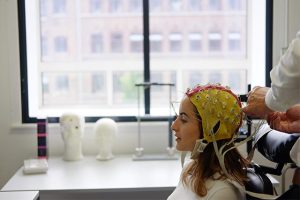Brain Scans In Neuromarketing
We will be exploring a form of interrogating the brain by recording the electrical activity responses after exposing it to marketing stimuli. For this, some technical instruments can be used, such as Electroencephalography (EEG), Transcranial Magnetic Stimulation (TMS), Magnetoencephalography (MEG), and Steady-State Topography (SST). Yes, I hear you! These names sound complicated, but I will keep this topic simple, so keep reading. If you are looking for information regarding neuromarketing methods recording metabolic activity in the brain, visit part 1 of this article.
You might be wondering: what does it even means to record electrical activity in the brain? So, I will start with that.
RECORDING ELECTRIC ACTIVITY IN THE BRAIN
While reading this your brain is sending off chemical and electrical signals to help you understand the meaning of the words and sentences. Your brain functions due to networks of tiny cells called neurons that communicate electrochemically among them to allow you to think, feel, and interact with the world around you. When brain activity occurs, positive ions rush in through channels in the neuronal membrane, and when the charge gets high enough, the neuron sends a signal to communicate with nearby neurons (Berg et al., 2019), and that generates an electrical impulse, and in broad terms is the electrical activity that gets recorded with the different tools we named before.
If you want to dive deeper into how the electrical activity in the brain works, you can begin with this video that gives a good and simple explanation.
RECORDING ELECTRIC ACTIVITY IN THE BRAIN FOR NEUROMARKETING STUDIES
Neuromarketing or consumer neuroscience utilizes the tools available in neuroscience to perform marketing-related studies. we will look at the Electroencephalography (EEG) to explore one of the options available to perform neuromarketing studies, by explaining how it works and looking at a real-life case.
ELECTROENCEPHALOGRAPHY (EEG)
EEG measures and records electrical activity in the form of brain waves, result of neural activity that happens directly below the scalp. EEG can show how much of the brain is engaged at given points in time. In neuromarketing studies, in the presence of a particular stimulus, such as a video advertising, neurons fire and produce electrical impulses that can be recorded through the EEG measurement caps that often look like a swimming cap, and consists of electrodes (sensors) that transmit the captured brain activity.

EEG caps come in different options. There are with “Wet electrodes” which use a conductive gel to improve signal quality and “Dry Electrodes” which do not require such gel. The gel used can be sticky and unpleasant for participants. Because of this, for market research purposes many opt for dry electrodes, to improve participation and compliance. Many EEG systems have moved from the bulky systems used in clinical settings to sleek, convenient wireless systems. This is allowing them to be used in a range of new settings, from simulations of a real-world scenarios, to use of EEG with virtual reality software. (Imotions.com)
The observed brain waves can be linked to different states of stimulation such as wakefulness (beta waves), relaxation (alpha waves), calmness (theta waves), and light and deep sleep (delta waves). Thus, the electrical potential measured and compared to a baseline level can provide a lot of information about a subject’s mental state.
In Neuromarketing, EEG is utilized to measure cognition, emotional valence, memory encoding, recognition, attention, excitement, engagement or boredom, approach or withdrawal. When testing taglines, new campaigns, testing and developing advertisements, testing-in store experience, movie trailers, website design and usability, and when identifying the key moments of an advertisement or video material (Thabani and Wellington, 2017).
For exmaple, PepsiCo used the EEG NeuroPricing research offered by Neurensics, to find out the possible impact of a price increase of 0.25 Turkish Lira on Lays chips in Turkey. The possible impact was studied using questionnaires and EEG –“NeuroPricing™”. The traditional marketing technique of questionnaires aimed at finding their opinion and the likelihood that they would buy after the price increase, this technique predicted a drop in sales of 33% making the price increase not profitable.
On the other hand, the EEG NeuroPricing technique predicted only a 9% drop in sales which would increase the profits for the company. For this tecnique, participants were randomly presented with Lays packages, each with a different price and were asked to indicate whether they thought it was ‘expensive’ or ‘cheap’. While at the same time, their brain activity got measured using EEG. Neurensics claims to have determined the exact brain regions that activate and indicate when the price is optimal or feels good to the participant, enabling them to predict the optimal price based on unconscious brain processes.
After the study, PepsiCo increased the price and shared the real sales figures with Neurensics. It turned out that sales were only 7% less than the previous year and that indeed increased profits! This case showed that measuring unconscious brain reactions, or interrogating the brain itself can bring better predictions than traditional marketing methods. ( Case source: Neurensics.com )
And to give you a visual example check out this video from Brainsigns, where is shown how participants using EEG and eye-tracking devices are put in a real-life scenario to measure their emotional’s level, cognitive involvement, and focus attention in different departments, and in exposure conditions of layout, packaging, and presence of promoters at the entrance of the store. (Complete case by brainsigns here)
https://www.youtube.com/watch?v=RFV-JVk5QBE



